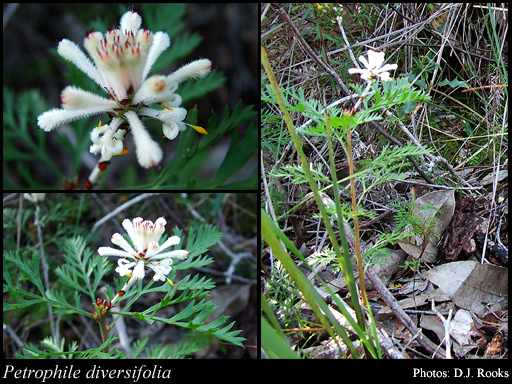- Reference
- Trans.Linn.Soc.London 10:70 (1810)
- Conservation Code
- Not threatened
- Naturalised Status
- Native to Western Australia
- Name Status
- Current
Slender, generally single-stemmed, non-lignotuberous shrub, 0.7-3 m high. Fl. cream-white-pink, Sep to Dec. Laterite, gravelly sandy soils, clay.

Scientific Description
Shrubs, 1.5-2 m high; branchlets hairy, with straight hairs. Leaves alternate, 30-110 mm long, glabrous; lamina flat, twice or more divided, pinnately divided, divided to the midrib, with (20-)35-54(-84) points or lobes; distance from base of leaf to lowest lobe 7-15 mm. Inflorescences not viscid, white, pink or grey. Perianth 10-13 mm long, hairy, the limb apex hairy all over; pistil 10-15 mm long; pollen presenter fusiform, hairy, 3.5-4 mm long. Cone with persistent scales, 20-25 mm long. Flowers in September, October, November or December. Occurs in the South-west (SW) Botanical Province(s), in the Swan Coastal Plain (SWA), Jarrah Forest (JF), Warren (WAR) or Esperance Plains (ESP) IBRA subregion(s).
Distribution
- IBRA Regions
- Esperance Plains, Jarrah Forest, Swan Coastal Plain, Warren.
- IBRA Subregions
- Fitzgerald, Perth, Southern Jarrah Forest, Warren.
- IMCRA Regions
- WA South Coast.
- Local Government Areas (LGAs)
- Albany, Augusta Margaret River, Busselton, Cranbrook, Denmark, Manjimup, Nannup, Plantagenet.